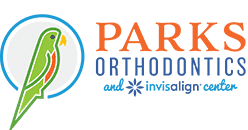Early orthodontic treatment provides timely detection of problems and greater opportunity for more effective treatment. Orthodontic treatment directs growth and helps to avoid potential complications in the future. When orthodontic intervention is not necessary, an orthodontist such as Dr. Meredith Parks can carefully monitor growth and development and begin treatment when it is ideal. For more information, read “A Parent’s Guide to Orthodontics.”
The American Association of Orthodontists (AAO) recommends that your child see an orthodontist by the age of seven to monitor the progress of newly erupting permanent teeth. Identifying orthodontic issues early, such as crowding, can be treated effectively during early orthodontic treatment.

Signs Early Orthodontic Treatment May Be Needed:
Here are some signs that could indicate your child needs early orthodontic treatment. It’s not always easy to identify, which is why we recommend bringing your child in to an orthodontic expert such as Dr. Parks:
Who Can Benefit From Early Orthodontic Treatment?
The first phase of early orthodontic treatment typically begins around the age of seven and lasts anywhere from one to two years. During this phase, we will focus on correcting any jaw growth or structural issues. The second phase of treatment begins after the permanent teeth have erupted and involves using braces to bring the teeth into proper alignment. When your child is in between phases, Dr. Parks will want to see them for periodic evaluations.
Why Should Malocclusions Be Treated?
According to studies by the American Association of Orthodontists, untreated malocclusions can result in a variety of problems.
Our Two-Phase Approach
At Parks Orthodontics, our goal is to help identify any potential orthodontic issues early in children. We achieve this in a two-phase treatment approach. The two-phases of orthodontic treatment are critical to achieving your child’s best possible results. The first phase, also known as the early treatment phase, works with your child’s growth. The second phase, also known as the comprehensive treatment or alignment phase, works to correct the teeth’s rotation and spacing as well as your child’s bite. When your child is in between phases, Dr. Parks will see them periodically for evaluations and monitoring appointments.
Contact Us Today
To determine if your child is a candidate for early orthodontic treatment, contact us! Dr. Parks will be happy to discuss any questions or concerns you may have. Fill out our online form today to schedule your child’s complimentary consultation, or you can call or text us. We look forward to meeting you and your family!

